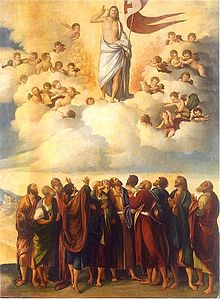Ascension of Jesus in Christian art
The Ascension of Jesus to Heaven as stated in the New Testament has been a frequent subject in Christian art, as well as a theme in theological writings.
[5][6] New Testament scenes that appear in the Early Christian art of the 3rd and 4th centuries typically deal with the works and miracles of Jesus such as healings, the multiplication of the loaves or the raising of Lazarus.
In early scenes Christ may be shown striding up a mountain, at times the Hand of God reaching from within the clouds to assist him.
Sometimes the last two footprints of Christ on the rock are seen; these were shown to pilgrims at what is now the Chapel of the Ascension on the Mount of Olives in Jerusalem.
[1] The name of the Assumption of Mary indicates that this was a passive transit; depictions in art often show her being carried up on a cloud by angels.
"[5] Thus in many Eastern icons the Virgin Mary is placed at the center of the scene in the earthly part of the depiction, with her hands raised towards Heaven, often accompanied by various Apostles.
Perhaps the earliest surviving works to show this iconography of the Resurrection is the well-known fresco by Andrea da Firenze in the Spanish Chapel of the Basilica of Santa Maria Novella in Florence, which dates to 1366.


